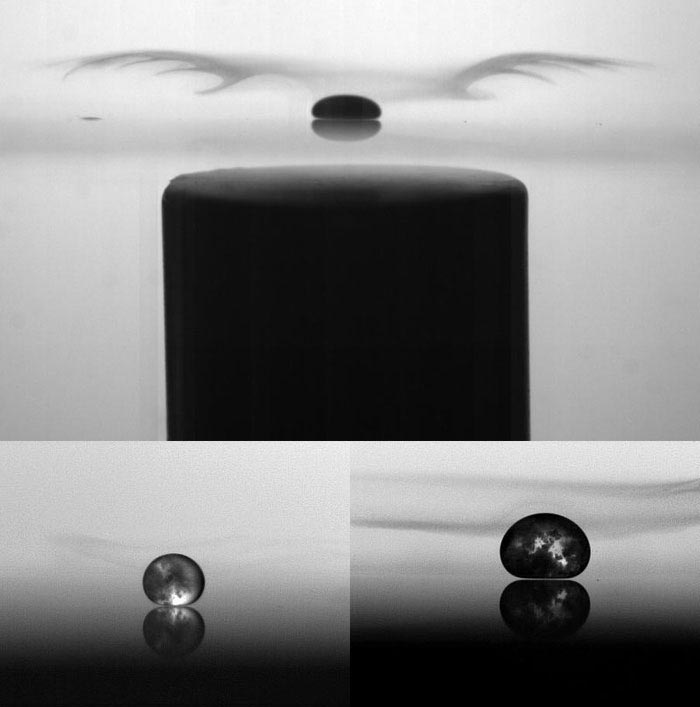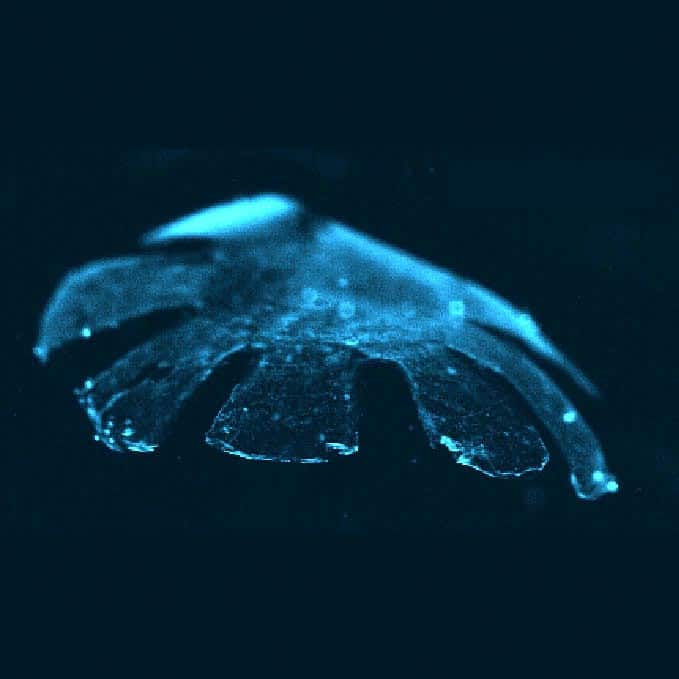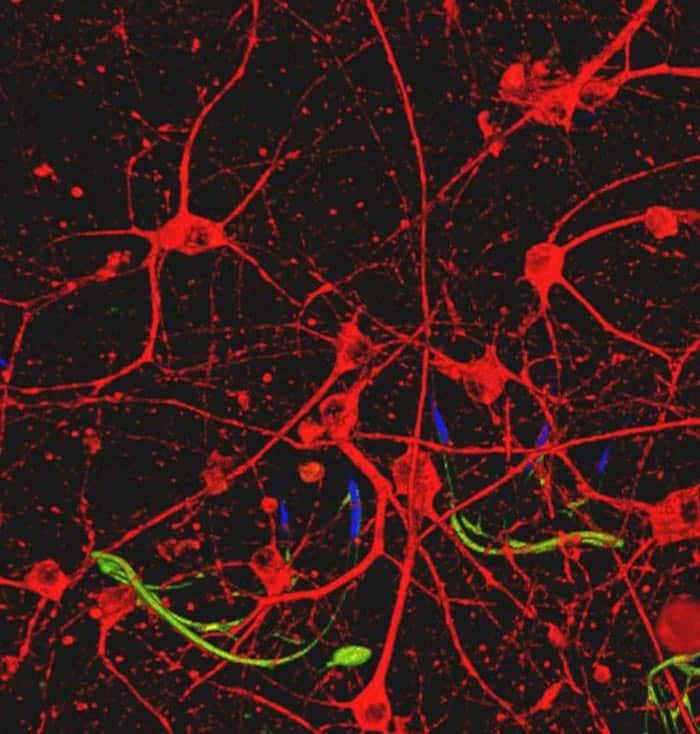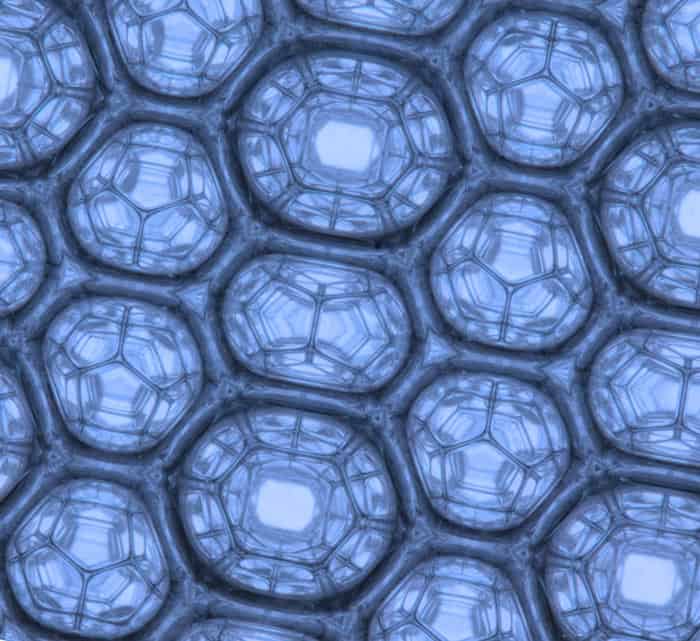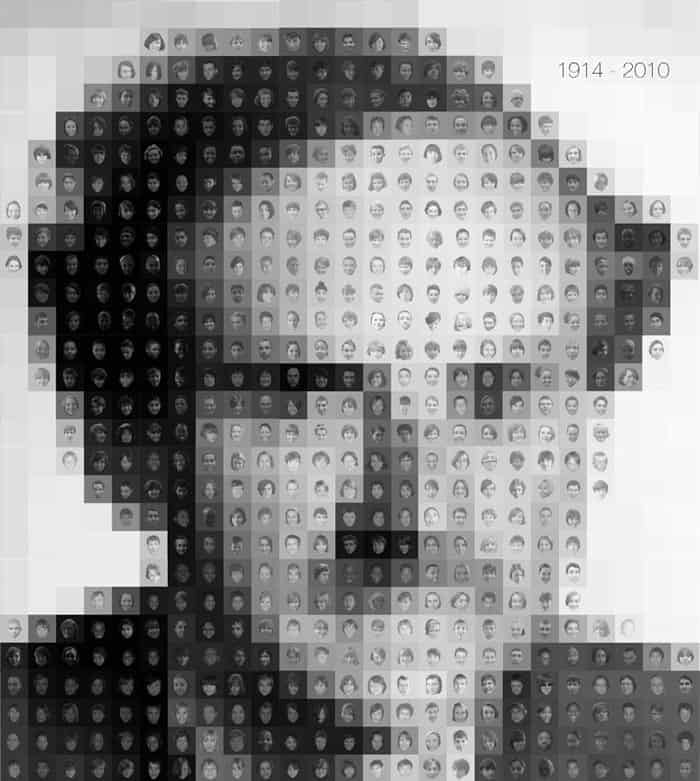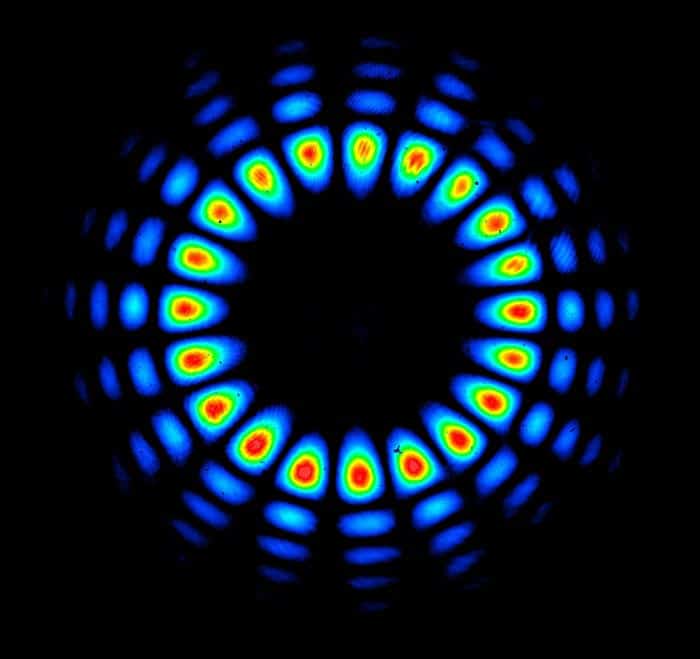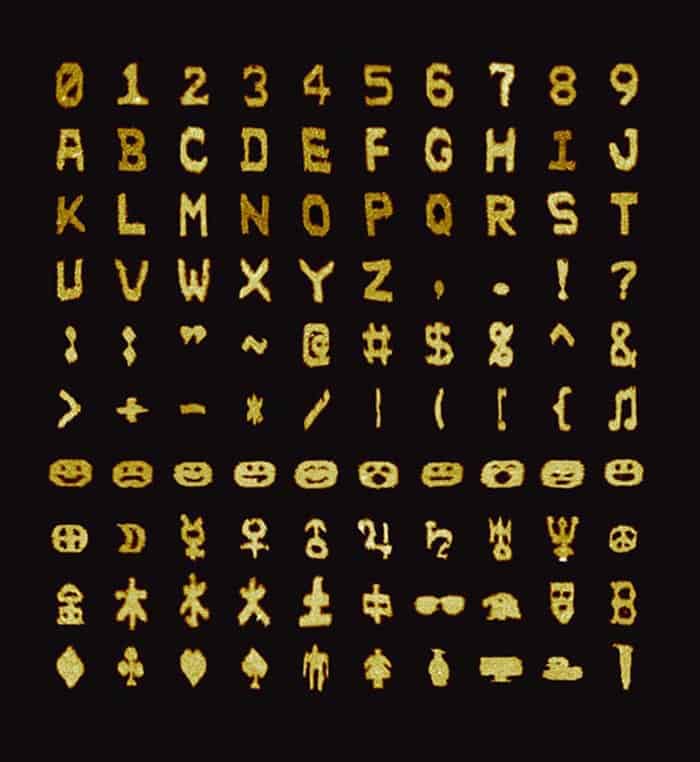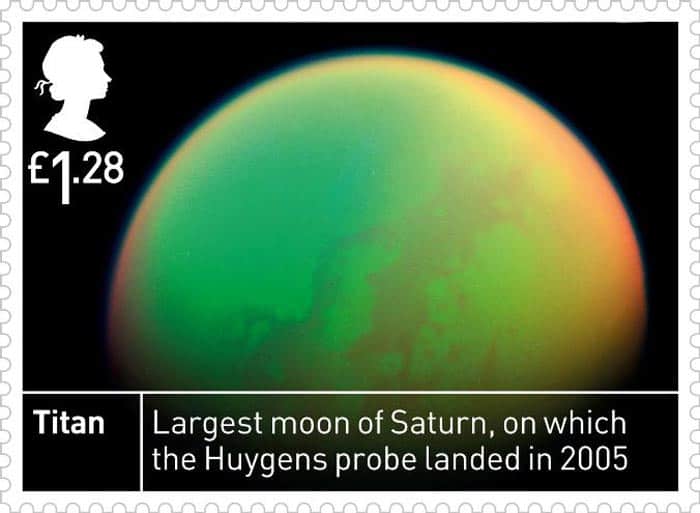Undoubtedly, 2012 has proved to be an exciting year for physics, with many complex and long-awaited discoveries keeping us busy. But every now and then we enjoy looking at the vivid visual beauty of physics. So, here are 12 images that show the many hues of physics for 2012, in no particular order. The images range from the micro to the macro world – from nanometre-sized DNA tiles to one of the largest moon’s of Saturn – Titan. We hope you enjoy them

GRAIL mission peers beneath the Moon’s fractured surface
This kaleidoscopic image is the first ever high-resolution map of the Moon’s internal gravitational field, as created by NASA’s Gravity Recovery and Interior Laboratory (GRAIL). Launched in September 2011 from Cape Canaveral in the US, the $495m mission consists of twin spacecraft named Ebb and Flow. This image shows the variations in the lunar gravity field measured during the primary mapping mission from March to May 2012. As well as revealing surface structures that had previously never been seen, GRAIL’s new data show that the lunar crust is less dense and more fractured by massive impacts than had been thought.
Levitating drops controlled by fridge magnets
If you are wondering what the ethereal image above is showing, you are in fact looking at levitating drops of liquid oxygen, known as “Leidenfrost drops”, floating above glass plates at room temperature. The Leidenfrost effect is seen when a liquid comes into contact with a surface that is at a significantly higher temperature than the liquid’s boiling point, producing an insulating layer of vapour that keeps the drop from evaporating rapidly. The images are part of a study where researchers show that it is possible to control a paramagnetic liquid drop using a magnetic field. The top image shows the magnet below the glass plate and a “cloud” above the liquid-oxygen drop, which is at –183 °C. Water vapour in the air around the drop condenses, forming these clouds that sometimes reveal the ambient air flows. The haze seen within the close-up drop images (below) is caused by ice crystals.
Artificial jellyfish engineered from rat heart cells
This vivid enhanced-colour image shows an artificial tissue-engineered jellyfish “swimming” in a container of ocean-like saltwater. Dubbed “Medusoid”, the bioengineered creature was fashioned from silicone rubber and powered by lab-grown rat heart tissue and swims just like its living analogue by pumping water in and out of its dome-shaped body in rhythmic pulses. Less than a centimetre in diameter when flat, Medusoid uses rat cardiac cells that were activated with a jolt of electricity to provide the “power stroke” and was built to resemble a juvenile moon jellyfish (Aurelia aurita). It possesses eight armlike appendages that bend to give it a characteristic dome shape when it surges forward.
Living tissue is laced with electronic sensors
While at first glance the image above might remind you of a Jackson Pollock painting, it is in fact a reconstructed 3D image showing a network of nanosensors, depicted in blue and green, lying alongside neurons, embedded in a tissue culture of rat hippocampal neurons. The picture is the result of work carried out by researchers at Harvard University, who teamed up with tissue engineers at the Massachusetts Institute of Technology and Boston Children’s Hospital to develop a better way of integrating tissue and electronics. Instead of using traditional electrode-based detectors – which deliver weaker signals when they are made smaller – the team opted for silicon field-effect transistors (FETs)as detectors. FET sensors can be extremely small – in this case made from 30 nm-diameter nanowires – and still give accurate readings.
Getting to the froth of the matter
Whether it is the frothy milk on your cappuccino, the soapy suds in your bath or the large-scale structure of the universe, foam has intrigued physicists for many years. The foam in the image above might have been made using everyday Fairy Liquid detergent, but it is also the first-ever example of a “Weaire–Phelanfoam”, which physicists believe is the lowest energy structure for a foam formed of equal-volume bubbles. This foam is a complex 3D structure of two kinds of equal-volume polyhedral bubbles, and is 0.3% lower in energy than a Kelvin foam. It is created by placing a special template in a simple solution of water and Fairy Liquid, with bubbles introduced by releasing nitrogen gas from a glass capillary. The resulting foam was backlit and photographed using a digital SLR camera.
My life on Mars
In December 2011 PhD student Ashley Dale spent two weeks in the Utah desert as part of a simulated Mars mission. He gave Physics World a riveting account of his two-week stay at the Mars Desert Research Station (MDRS), a facility dedicated to developing and testing field tactics and protocols for a human expedition to Mars. His trip saw him do everything from riding on quad bikes to eating dehydrated food. The mission also aimed to study the potential psychological effects of travelling to Mars. The picture above was taken on site by Dale.
New metamaterial switches handedness on demand
A new metamaterial with a handendness, or “chirality”, that can be switched on demand was created by an international team of physicists. Operating in the terahertz region of the electromagnetic spectrum, the material can be used to manipulate the polarization of terahertz waves. The scanning electron microscope (SEM) image to the left shows the metamaterial, which is an array of V-shaped resonators. The white scale bar is 25 μm. The SEM image to the right shows one of the resonators and the scale bar is 10 μm. The pink, blue and orange structures are made of gold, while the green structures are silicon.
Dirac seen in a new light
You might need to scrunch up your eyes and lean away from your keyboard, but the image above is the face of one of the great theoretical physicists of the 20th century – Paul Dirac. Dirac studied for two separate degrees in engineering and mathematics at the University of Bristol – the city where Physics World is based – and before that was a pupil at Merchant Venturers’ Technical College – an institution that was the forerunner of today’s Cotham School. Created by Eric Hardy, the work is an alternative version of the traditional end-of-year school photograph, where each pixel has been replaced by photos of pupils, teachers and other members of staff at Cotham School. The original artwork, which is printed on a canvas about 100 × 90 cm in size, was on display at the school in May when its other great former pupil – the University of Edinburgh theorist Peter Higgs – paid a visit.
Spooky action with twisted beams
This rather vivid Pointillist-style image depicts a feat of quantum physics, showing 20 photons entangled using their “orbital angular momentum”. It was created by researchers based in Austria, who say that the large amount of orbital momentum they have imparted to the photons paves the way for the entanglement of macroscopic objects. Giving photons orbital angular momentum means twisting a beam’s wavefront so that, as the beam travels forward, its wavefront rotates around the propagation axis. The false-colour image shows a laser beam exhibiting a superposition of 10 right-handed and 10 left-handed quanta of orbital angular momenta, making 20 bright spots on the inner ring. This research was also featured as one of our top 10 breakthroughs of 2012.
Fossilized raindrops dampen theory of ancient warming
This image of a meerkat looming over a specimen of fossilized raindrops made us smile. The animal is perched on top of rocks bearing the fossil impressions of raindrops that fell in South Africa 2.7 billion years ago and that were used by researchers in the US to work out what the air pressure on Earth was billions of years ago. By analysing the shapes and sizes of raindrop imprints in volcanic ash, the team has shown that the atmospheric pressure in the Archaean eon was roughly the same as it is today. This is at odds with a popular theory of how the Earth stayed warm enough for life to exist at the time.
DNA tiles pave the way
This image may look like a collection of novelty spaghetti shapes but these detailed figures are in fact made from assemblies of DNA strands, as imaged by an atomic force microscope (AFM). The pioneering method, developed at Harvard University in the US, is used for engineering complex nanoscale structures from a set of DNA “tiles”. The canvas above shows AFM images of 100 distinct shapes, including the capital letters of the Latin alphabet, emoticons and astrological symbols, with each shape taking just one hour to produce. These images have been enlarged and their real sizes are 150 nm × 150 nm. This set of tiles costs roughly £4500, but the researchers estimate that it could make 2 × 1093 possible shapes.
Stamping across the solar system
In October this year, the UK’s Royal Mail issued a set of six special stamps to celebrate the 50th anniversary of Britain’s first satellite – Ariel 1 – that was launched on 26 April 1962. All six images were taken from missions conducted by the European Space Agency (ESA) and include the cavernous craters of Mars, the dizzying rings of Saturn, a close-up image of the Sun and a filament, a green-tinged picture of Titan – Saturn’s largest moon, the Lutetia asteroid and a shimmery picture of the south pole of Venus. You can buy the set at the Royal Mail website.
